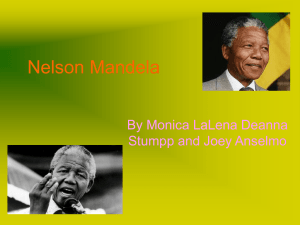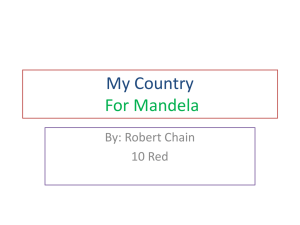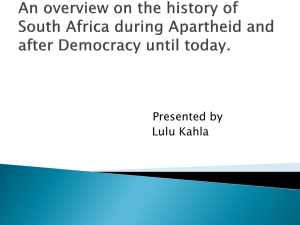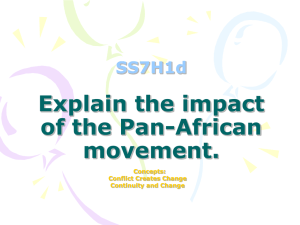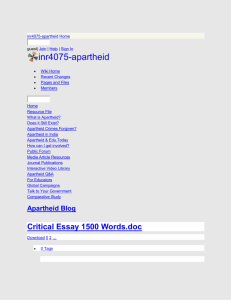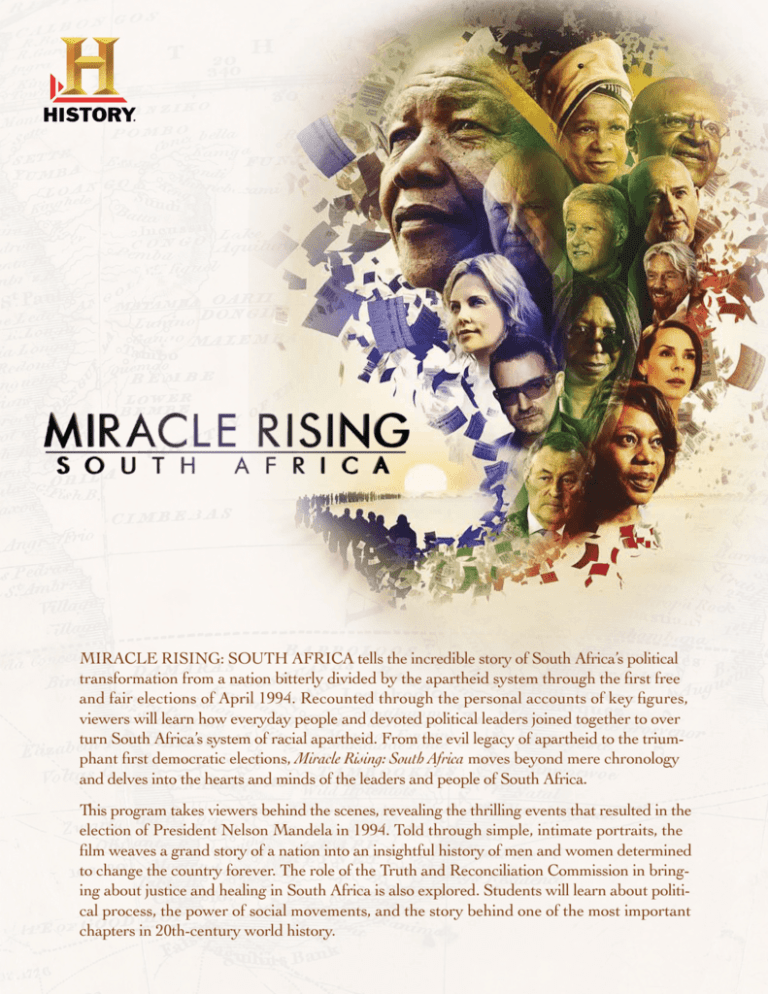
Miracle Rising: South Africa tells the incredible story of South Africa’s political
transformation from a nation bitterly divided by the apartheid system through the first free
and fair elections of April 1994. Recounted through the personal accounts of key figures,
viewers will learn how everyday people and devoted political leaders joined together to over
turn South Africa’s system of racial apartheid. From the evil legacy of apartheid to the triumphant first democratic elections, Miracle Rising: South Africa moves beyond mere chronology
and delves into the hearts and minds of the leaders and people of South Africa.
This program takes viewers behind the scenes, revealing the thrilling events that resulted in the
election of President Nelson Mandela in 1994. Told through simple, intimate portraits, the
film weaves a grand story of a nation into an insightful history of men and women determined
to change the country forever. The role of the Truth and Reconciliation Commission in bringing about justice and healing in South Africa is also explored. Students will learn about political process, the power of social movements, and the story behind one of the most important
chapters in 20th-century world history.
Primary Source: Mandela’s Release
After serving 27 years in prison for his anti-apartheid activism,
Nelson Mandela was finally released on February 10, 1990. Above
is the final segment of a speech Mandela gave the day after his
release in Cape Town, South Africa. Students can also locate the
full text of the speech online for a deeper analysis of Mandela’s
words upon his release.
“T
Q
o lift sanctions now would be to run the
risk of aborting the process towards the complete
eradication of apartheid.
Our march to freedom is irreversible.
We must not allow fear to stand in our way.
Universal suffrage on a common voters roll in
a united, democratic and non-racial
South Africa is the only way to peace
and racial harmony.
In conclusion, I wish to quote my own words
during my trial in 1964.
They are as true today as they were then.
I quote:
‘I have fought against white domination and
I have fought against black domination.
I have carried the ideal of a democratic and
free society in which all persons live
together in harmony and with equal opportunity.
It is an ideal which I hope to live for and to achieve.
But, if needs be, it is an ideal for which I am
”
prepared to die.’
— EXCERPT FROM NELSON MANDELA’S ADDRESS AFTER HIS RELEASE FROM
PRISON, DELIVERED IN CAPE TOWN, SOUTH AFRICA ON FEBRUARY 11, 1990
Q
Primary-Source Discussion Questions
1. What does Mandela say is the best path to peace and harmony
in South Africa?
2. This speech was delivered right after Mandela was released, after having served 27 years in prison for his anti-apartheid activities.
How does he conclude his speech? Why do you think he chose to end
the speech with a quote from years before?
Did You Know? For the majority of the time he was incarcerated,
Nelson Mandela was at Robben Island prison. Today, Robben
Island is a UNESCO World Heritage site. Visit whc.unesco.org/
en/list/916 to learn more. Do you think it is important to save
this site for the future?
Vocabulary
Using a dictionary or other source, ask students to define the following terms used in this program. Defining these terms will give
students a deeper understanding of the topics explored in this
documentary.
acquiescence
persecution
amnesty
reconciliation
apartheid
retribution
exile
sabotage
paradigm
transcend
Curriculum Links
Miracle Rising: South Africa would be useful for History, Global
Studies, Politics, Race and Ethnic Studies, Social Studies, and Journalism courses. It is appropriate for mature high school and college
students. Due to some intense content, we do not recommend it for
younger students.
Extended Activities
1. Voices Against Apartheid.
This program explores the contributions of many individuals in the
movement to end apartheid, including Nelson Mandela, Ruth First,
Phila Portia Ndwandwe, Stephen Biko and Chris Hani. Ask students to choose one of these people or another contributor to the
anti-apartheid movement. Students can research the individual
they chose and write a short essay or create a visual presentation
about this anti-apartheid leader.
2. Challenging Apartheid.
In this documentary, viewers learn about the movement against
apartheid. In addition to the movement within South Africa, there
were also communities throughout the world who joined the effort
to end apartheid, including organizing boycotts of South Africa
until change occurred. In small groups or individually, ask students
to research the anti-apartheid movement and create posters or
flyers that may have been created during this era. Students can
search online to find many examples of actual posters created
during this era.
Additional Resources
WEBSITES
Nelson Mandela on History.com:
www.history.com/topics/nelson-mandela
Discussion Questions
1. What does the term “apartheid” mean, and how was it practiced
in South Africa?
2. W
hat were some of the ways South Africans resisted apartheid?
How did they attempt to overturn this system?
3. What were the risks of fighting against apartheid in South Africa?
The Apartheid Museum:
www.apartheidmuseum.org
The Nelson Mandela Centre of Memory:
www.nelsonmandela.org
Noble Prize.org Biography:
www.nobelprize.org/nobel_prizes/peace/laureates/1993/
mandela-bio.html
4. What were some of the biggest challenges to the implementation
of democratic elections in South Africa? Why do you think people
fought for justice despite the risks?
BOOKS
5. After almost 30 years in prison, Nelson Mandela was released in
1990. Chosen to lead the newly restored ANC, how did Mandela
approach the South African government that had imprisoned him
for three decades?
Mandela, Nelson. Long Walk to Freedom. (Back Bay Books, 1995).
6. There was incredible violence during the apartheid era. How do
you think those who committed violence should have been held
accountable for their actions?
Koosmann, Melissa. The Fall of Apartheid in South Africa.
(For young readers). (Mitchell Lane Publishers, 2009).
Mathabane, Mark. Kaffir Boy: The True Story of a Black Youth’s
Coming of Age in Apartheid South Africa. (Touchstone, 1998).
Van Wyk, Chris. Nelson Mandela: Long Walk to Freedom.
(Flash Point, 2009).
Worden, Nigel. The Making of Modern South Africa: Conquest,
Apartheid, Democracy. (Wiley-Blackwell, 2007).
7. What was the Truth and Reconciliation Commission?
8. What was the National Peace Accord, and how did it pave the way for democratic elections in South Africa?
9. In this program, Charles Villa-Vicencio explains the meaning of the
Zulu word “sawubona,” which translates as “I see you. I see you
and you see me.” What is the significance of this phrase in the
context of post-apartheid South Africa?
10. What was the outcome of the first free election in South Africa?
Why was this era such a significant chapter in world history?
©2013 A&E Television Networks, LLC. All rights reserved. 0163A.


